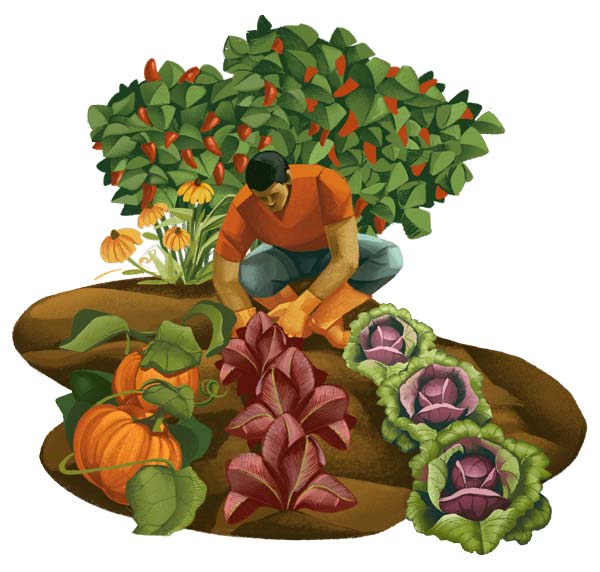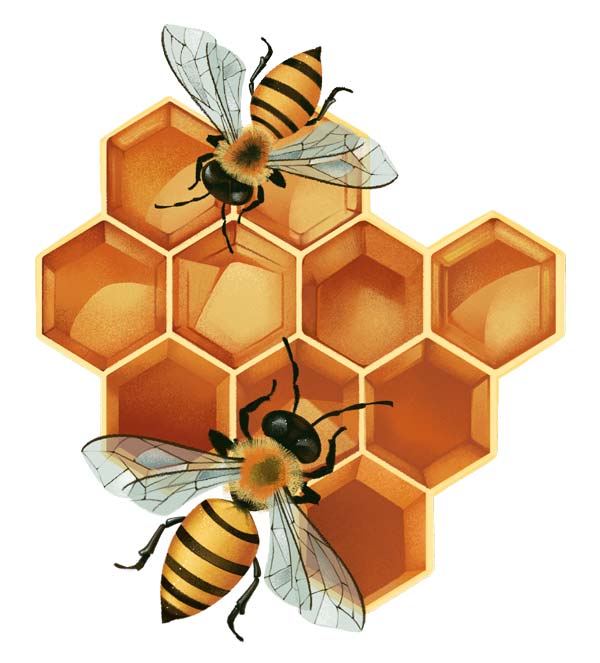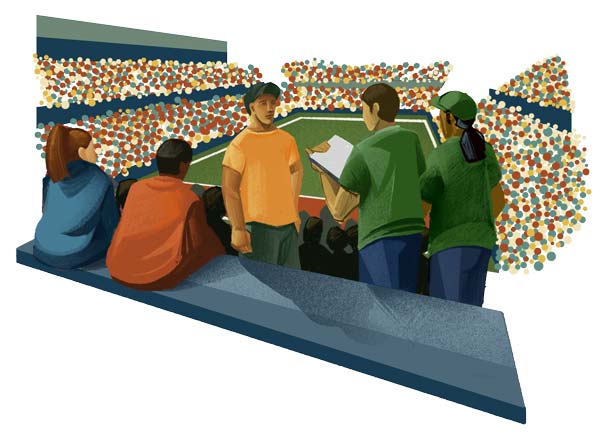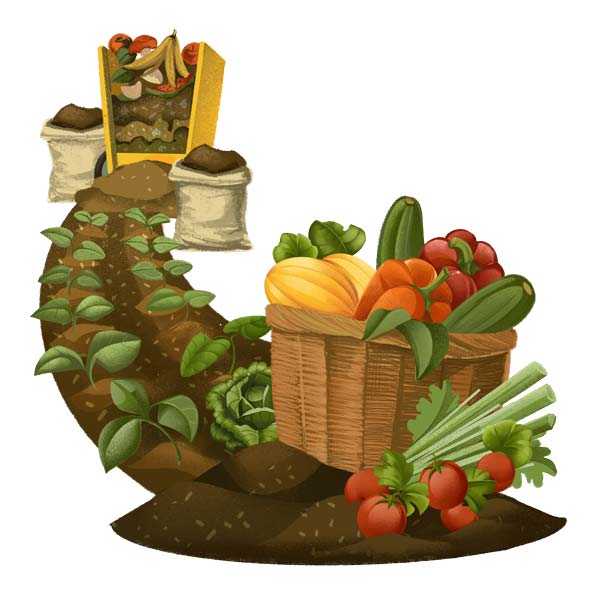Hot Ticket
There’s nothing like a sold-out game at sports-mad BC. Just ask head of ticket sales Jim O’Neill.

Illustrations By Chiara Vercesi
What Sustainability Looks Like at Boston College
Everywhere you turn, the BC community is building a greener future.
Boston College’s work to decrease its carbon footprint, reduce waste, and preserve the health of the natural environment has been generating acclaim for years now. The University, for instance, has received a coveted Gold rating in the STARS program of the Association for the Advancement of Sustainability in Higher Education. And last fall, Mass Save, an energy-efficiency initiative run by Massachusetts power companies, recognized BC as one of nineteen organizations in the state that are leading the way in curbing energy use and working toward a net-zero future. But what does sustainability look like at BC?
You can see it in everything from innovative technologies that repurpose water and heat in the University’s sparkling new academic buildings to the green energy that’s produced from composted dining-hall leftovers; from the bees pollinating campus flowers to a program that collects and donates students’ used furniture, clothing, and books that might otherwise find their way into the waste stream. “What I cherish most about BC’s sustainability community is the collaborative spirit that brings together students, faculty, and staff across all disciplines,” said Amy Rini ’26, a graduate assistant in the Office of Sustainability. “The passion and dedication I see in our Eagle community is truly inspiring.”
Here’s a look at just some of the many ways that BC is contributing to a greener and more sustainable future.

Located behind Connolly House, the University garden is overseen by Real Food BC, one of several student environmental clubs on campus. Real Food BC uses the garden’s harvest—including cucumbers, tomatoes, watermelon, beans, and squash—in sustainable cooking classes and events it hosts to teach students how to do everything from pickle veggies to prepare a delicious stuffed squash. The group is also working with UGBC, the Office of Sustainability, and other student clubs on a program to promote composting in dorms and off-campus housing, which could also ultimately help the garden. “We’ll go collect those composting bins once or twice a week and then dump those directly into the garden,” said Real Food BC member Lily Arouth ’27.

Though many people are unaware of it, the Fulton Hall rooftop houses a beehive that for nearly a decade has served as a site for important environmental research. The hive, home to many thousands of bees, was made possible through a 2016 donation from the parents of two BC alumni. Each month during the spring, summer, and fall, a beekeeper from the company that manages the hive visits campus to collect data and monitor everything from signs of disease to the state of the queen bee’s health and the colony’s strength. The findings offer insights into the local area’s biodiversity, climate shifts, and ecosystem. Of course, the hive also produces honey, which researchers examine to determine the plants that BC’s bees are most often visiting and pollinating. More importantly, the honey is delicious, which is why BC Dining often serves it at University events.

For decades, BC students packing up after a long school year have had a welcome option for keeping unwanted items out of the waste stream. Instead of throwing away old clothing, books, furniture, and appliances, the students can give them to BC Clean, which donates the items to local charities. Here’s some of what was collected last year.
Refrigerators
Pounds of clothing
Appliances and furniture items
Pounds of books
Pounds of textiles

Boston College is famous for its spectacular, tree-filled campus. Here’s a by-the-numbers look at all that greenery.
Trees across BC’s campuses
Gallons of rainwater absorbed annually by BC’s trees
Pounds of carbon dioxide offset each year by the iconic Littleleaf Linden trees that line Linden Lane
Different tree species found around BC
European Larch tree (which grows near O’Neill Plaza)

Each year, the BC Office of Sustainability sends student “green
ambassadors” out to football, basketball, and hockey events to promote recycling and awareness of BC’s eco-friendly programs. How many of these questions, which the ambassadors ask BC sports fans, can you answer correctly?
1. BC has which of the following?
a. A wind turbine on top of Conte Forum
b. Solar panels on the Merkert roof
c. A greenhouse in Higgins Hall
2. Which of these green services is found at BC?
a. A bike repair station at Duchesne Hall
b. A bike repair station in the Comm. Ave. Garage
c. Electric vehicle charging stations in the Comm. Ave. Garage
d. All of the above
3. What color are BC’s compost bins?
a. Green
b. Yellow
c. Purple
d. Blue
4. Which of these tree species does BC have on campus?
a. Pecan
b. Palm
c. Sequoia
d. Apple
Answers: 1.c.; 2.d.; 3.b.; 4.c.

When most of us think of composting, it’s gardening that comes to mind. But at BC, the food waste collected in composting bins is actually converted into green energy. Each dining hall on campus has a bin that is emptied six times per week by a local company. The material is then taken to a nearby facility operated by the company WM, where it’s screened to remove any contaminants, like plastic packaging. It’s then blended and transported to a wastewater treatment plant, where it undergoes an anaerobic digestion process that converts it into energy sources such as electricity and what’s known as renewable natural gas. One ton of food waste processed in this way has the potential to generate enough electricity to power between eight and ten homes per day, according to WM. Last year, 376 tons of food waste was collected from BC. The University also contributes approximately four hundred tons of leaf and yard waste per year to composting efforts, which convert the green waste into a nutrient-rich topsoil blend that commercial landscapers use for lawns. ◽